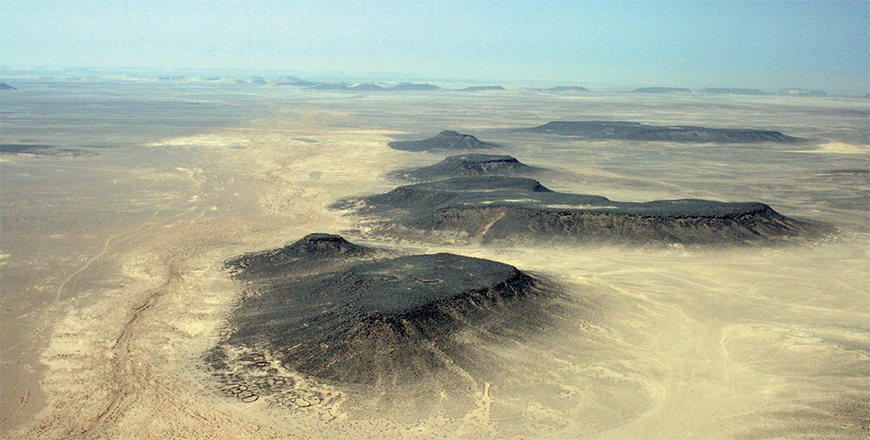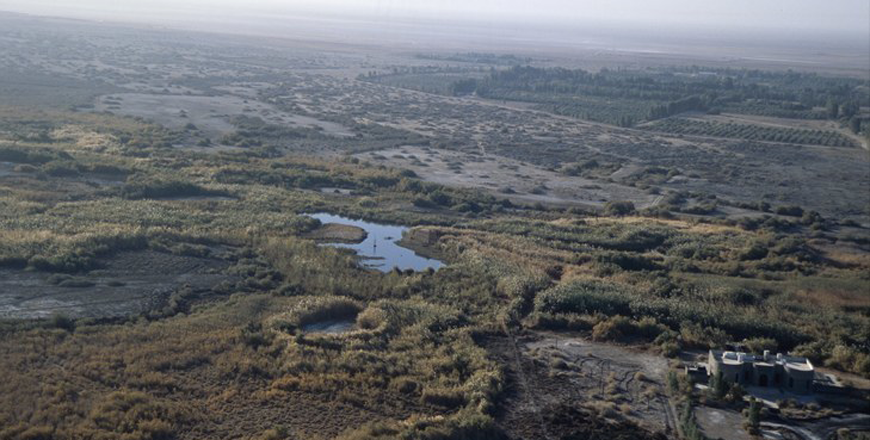You are here
Human habitation in North-East Jordan: Focusing on Neolithic hunter-herder trappers
By Saeb Rawashdeh - Jun 30,2024 - Last updated at Jun 30,2024

Looking south, mesas along western side of Wadi Qattafi (Photo courtesy of Eastern Badia Archaeological Project)
AMMAN — The eastern Black Desert is an area between modern Syria, Jordan and Saudi Arabia with plenty of evidence for the hunting activities from the prehistory until modern times. The hunting population in the Epipalaeolithic and Neolithic developed different technique to hunt prey which left multitude of evidence to zooarchaeologists who studied herding of goats and sheep. One of the widespread hunting technique were so-called desert kites used for gazelle populations in the region. The presentation titled “Neolithic hunter-herder trappers of Jordan East Badia” was held at the CBRL Amman Institute on Wednesday.
The lecture of the scholar Luise Martin tried to answer on questions of the longstanding debate on factors underlying human habitation of the north-east Jordan steppe/desert.
“We do this by presenting science-based archaeological evidence for wildlife presence, seasonal hunting opportunities and practices from ten chronologically varied prehistoric sites located in and around the Azraq Basin,” Martin said, adding that the focus of the lecture were Wisad Pools and Wadi Qattafi, two sites located in eastern Jordan.
Despite the steady stream of archaeological fieldwork and research focused on the early prehistory of the Levantine steppes/deserts, it remains unclear whether these currently semi-arid to arid regions were only visited by hunter-gatherers on a seasonal basis in the Epipalaeolithic and Neolithic periods, or whether they could have sustained more prolonged, or year-round, occupation, Martin elaborated, adding that this is the case with the north-east Jordan Badia, where some have viewed Neolithic sites in particular as being wet-season components of wider settlement systems based in the lusher Mediterranean zones, while others have argued for more autonomous systems with distinct traditions situated year round in the steppe.
The lecture examined one of the theories that favours the seasonal occupation of these sites. Following this argument, the strong environmental seasonality and lack of perennial water sources would mean that reliable herd grazing, and thus richly resourced hunting grounds, would have been confined to winter and spring, Martin elaborated, adding that as a consequence, gazelle herds would have migrated seasonally in and out of the Badia.
Zooarchaeological analysis discovered remains of big cats, lions and panthers in the Black Desert.
The desert kites also played an important role in hunting of gazelles and other games. The desert kites were stone structures found in Syria, Jordan and Saudi Arabia.
“Most researchers reasonably presume that kite structures primarily targeted migrating gazelle herds [along with wild asses], and while there is evidence that some kites were constructed in the early Neolithic, the dating of other major kite systems is still debated,” Martin said, adding that to date, researchers have been unable to empirically assess the validity of the gazelle migration model for the Jordanian Badia area in prehistory.
A small number of preliminary results have been retrieved from the Natufian/PrePottery Neolithic A (PPNA) Shubayqa sites, but the limited sample size prevents us from proposing a reliable picture for these periods, the scholar continued, adding that background archaeological research reveals occupation in areas of what is now the north-eastern Jordanian steppe-desert at stages through the late Upper Palaeolithic, the Epipalaeolithic and the Neolithic.
“It should be noted, however, that there were breaks in the sequence in north-east Jordan and differences in evidence of occupation between the limestone areas to the west, the Azraq oases, the basaltic areas on the relatively well-watered flanks of Jabel Druze to the north, and the basaltic steppe to the east,” Martin explained, noting that with the exception of the PPNA, the limestone areas and Azraq oasis have evidence of occupation from most periods between the Early Epipalaeolithic and Late Neolithic.
However, the basalt steppe to the east of Azraq has no evidence of occupation prior to the late Epipalaeolithic and also lacks the PPNA. The latter has only been found in the better watered basalt steppe in the northern Azraq Basin at Shubayqa, Martin highlighted, adding that Palaeoenvironmental reconstruction supports the concept that areas of the north-east Jordan Badia were very habitable during stages of the late Pleistocene and early Holocene.
“While sample sizes for analyses are sometimes small, results suggest large-scale shifts in gazelle habitats in the Badia between the Early Epipalaeolithic and PPNB/Late Neolithic, which we attribute more to the effects of encroaching pastoralists and their flocks than to shifts in environments, which arid-adapted gazelle herds should be able to withstand,” Martin said, noting that future studies on larger samples from the Late Epipalaeolithic can potentially add understanding of how wildlife responded to later Pleistocene environmental and cultural conditions.
“Standard zooarchaeology is useful but limited in this respect since it necessarily interprets animal ‘deadstock’, rather than more nuanced information about location and seasonality of animals during life as provided by isotopic analysis,” Martin underscored.
Related Articles
AMMAN — The Azraq Basin covers some 12,000 kilometres of the north-central Jordanian Plateau and currently ranges from moist steppe in the n
AMMAN — The Western Harra Survey (WHS), started in 2015, has been investigating the north-east of the Azraq basin, noted a British archaeolo
AMMAN — According to the professor Zeidan Kafafi, in Jordan, and during the second half of the last century, only very few sites from Pre-Po














